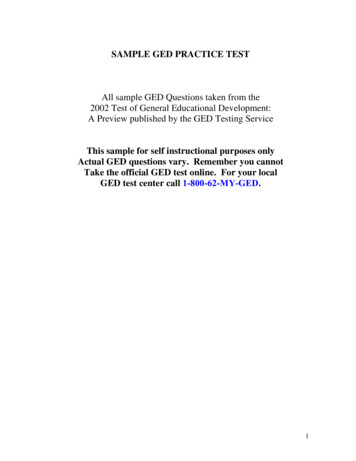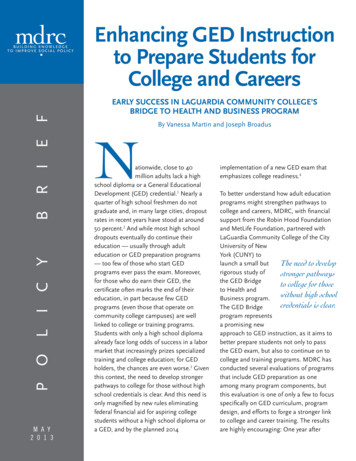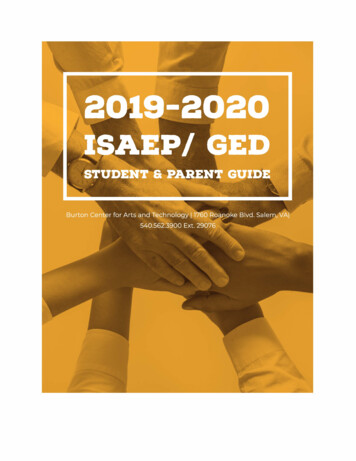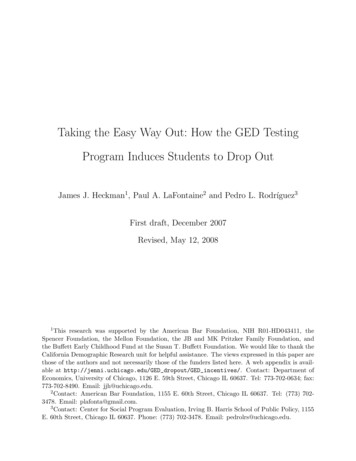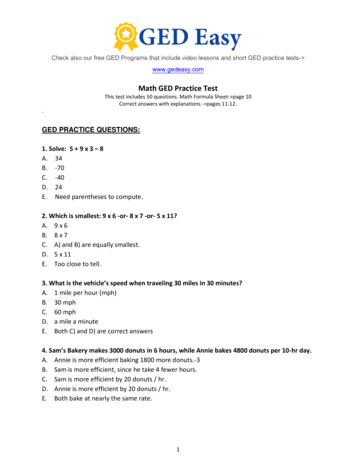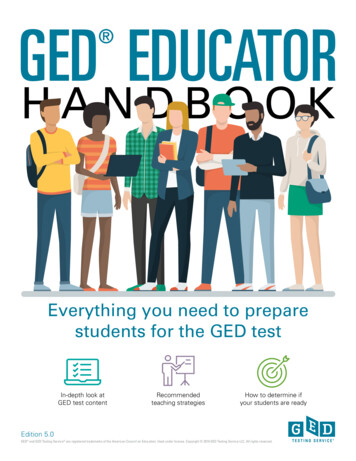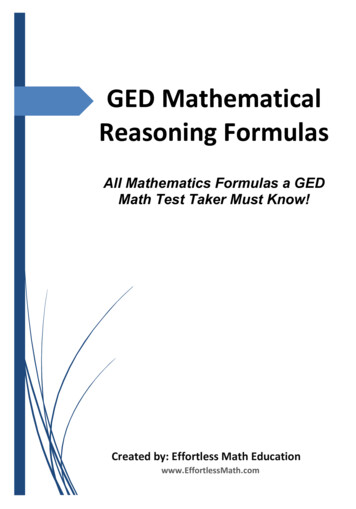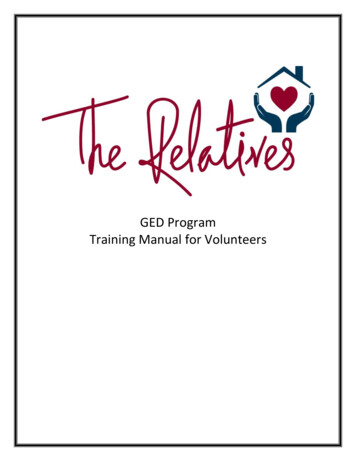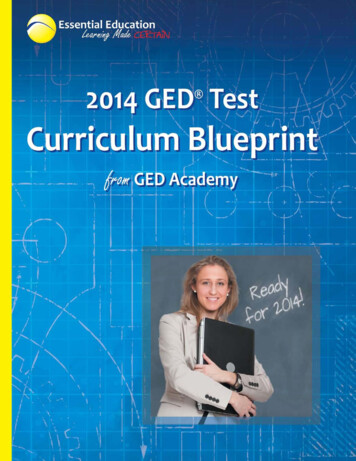
Transcription
2014 GED Test Curriculum Blueprintfrom GED AcademyAn Educator’s Guide to Being GED Test-Ready
2014 GED Test Curriculum Blueprint from GED Academy.Copyright 2013 by Essential Education. All rights reserved.No part of this book may be reproduced in any form or by any means, electronicor mechanical, without written permission from Essential Education, except forworksheets and lesson plans used for classroom preparation and in the case ofbrief quotations embodied in critical articles and reviews.For more information, contact:Essential Education Corporation895 NW Grant AvenueCorvallis, OR 97330phone: 800-931-8069GED is a registered trademark of the American Council on Education (ACE) andadministered exclusively by GED Testing Service LLC under license. This materialis not endorsed or approved by ACE or GED Testing Service.Essential Education provides innovative, effective GED test preparation andadult learning programs centered on the learner’s needs.For more information, please visit http://www.passGED.com/educators/.
Table of ContentsSection 1: What Will Change on the 2014 GED Test. . . . . . . . . . . . . . . . . . . . . . 1The Big Picture. . . . . . . . . . . . . . . . . . . . . . . . . . . . . . . . . . . . . . . . . . . . . . . . . . . . . . . . . . . . . 3Adjusting Your Curriculum . . . . . . . . . . . . . . . . . . . . . . . . . . . . . . . . . . . . . . . . . . . . 3Aligned with Common Core State Standards (CCSS) . . . . . . . . . . . . . . . . 4Webb’s Depth of Knowledge (DOK)Instead of Bloom’s Taxonomy. . . . . . . . . . . . . . . . . . . . . . . . . . . . . . . . . . . . 5Computer-Based Testing . . . . . . . . . . . . . . . . . . . . . . . . . . . . . . . . . . . . . . . . . . . . . . 5A Moving Target for Passing the GED Test . . . . . . . . . . . . . . . . . . . . . . . . . . . 62014 GED Mathematical Reasoning Test . . . . . . . . . . . . . . . . . . . . . . . . . . . . . . . . . 7In a Nutshell. . . . . . . . . . . . . . . . . . . . . . . . . . . . . . . . . . . . . . . . . . . . . . . . . . . . . . . . . . . . 7New Content. . . . . . . . . . . . . . . . . . . . . . . . . . . . . . . . . . . . . . . . . . . . . . . . . . . . . . . . . . . 7More Clarity with Skill Articulation . . . . . . . . . . . . . . . . . . . . . . . . . . . . . . . . . . . 8Mathematical Practices . . . . . . . . . . . . . . . . . . . . . . . . . . . . . . . . . . . . . . . . . . . . . . . 9Calculator . . . . . . . . . . . . . . . . . . . . . . . . . . . . . . . . . . . . . . . . . . . . . . . . . . . . . . . . . . . . . 11Math Item Types. . . . . . . . . . . . . . . . . . . . . . . . . . . . . . . . . . . . . . . . . . . . . . . . . . . . . . 112014 Reasoning Through Language Arts (RLA) Test. . . . . . . . . . . . . . . . . . . . 12In a Nutshell. . . . . . . . . . . . . . . . . . . . . . . . . . . . . . . . . . . . . . . . . . . . . . . . . . . . . . . . . . . 12One Test, Not Two. . . . . . . . . . . . . . . . . . . . . . . . . . . . . . . . . . . . . . . . . . . . . . . . . . . . 12Concentration on Informational Text. . . . . . . . . . . . . . . . . . . . . . . . . . . . . . . . 12Two Overarching Reading Standards. . . . . . . . . . . . . . . . . . . . . . . . . . . . . . . . 13Additional Reasoning Skills to Be Tested. . . . . . . . . . . . . . . . . . . . . . . . . . . . 13The Essay, or Extended Response. . . . . . . . . . . . . . . . . . . . . . . . . . . . . . . . . . . 14Computer Scoring for Extended Response Items . . . . . . . . . . . . . . . . . . 14Computer-Based Testing Requirements. . . . . . . . . . . . . . . . . . . . . . . . . . . . . 15Language Content Domain. . . . . . . . . . . . . . . . . . . . . . . . . . . . . . . . . . . . . . . . . . . 16RLA Item Types . . . . . . . . . . . . . . . . . . . . . . . . . . . . . . . . . . . . . . . . . . . . . . . . . . . . . . . 162014 Science Test . . . . . . . . . . . . . . . . . . . . . . . . . . . . . . . . . . . . . . . . . . . . . . . . . . . . . . . . . 17In a Nutshell. . . . . . . . . . . . . . . . . . . . . . . . . . . . . . . . . . . . . . . . . . . . . . . . . . . . . . . . . . . 17
Science Practices . . . . . . . . . . . . . . . . . . . . . . . . . . . . . . . . . . . . . . . . . . . . . . . . . . . . . 17Science Content and Focusing Themes. . . . . . . . . . . . . . . . . . . . . . . . . . . . . . 17Science Item Types . . . . . . . . . . . . . . . . . . . . . . . . . . . . . . . . . . . . . . . . . . . . . . . . . . . 182014 Social Studies Test . . . . . . . . . . . . . . . . . . . . . . . . . . . . . . . . . . . . . . . . . . . . . . . . . . 19In a Nutshell. . . . . . . . . . . . . . . . . . . . . . . . . . . . . . . . . . . . . . . . . . . . . . . . . . . . . . . . . . . 19Social Studies Content . . . . . . . . . . . . . . . . . . . . . . . . . . . . . . . . . . . . . . . . . . . . . . . 19Social Studies Practices . . . . . . . . . . . . . . . . . . . . . . . . . . . . . . . . . . . . . . . . . . . . . 20New Skills . . . . . . . . . . . . . . . . . . . . . . . . . . . . . . . . . . . . . . . . . . . . . . . . . . . . . . . . . . . . 20Focusing Themes . . . . . . . . . . . . . . . . . . . . . . . . . . . . . . . . . . . . . . . . . . . . . . . . . . . . . 21Extended Response . . . . . . . . . . . . . . . . . . . . . . . . . . . . . . . . . . . . . . . . . . . . . . . . . . 21Social Studies Item Types . . . . . . . . . . . . . . . . . . . . . . . . . . . . . . . . . . . . . . . . . . . . 22Item Types . . . . . . . . . . . . . . . . . . . . . . . . . . . . . . . . . . . . . . . . . . . . . . . . . . . . . . . . . . . . . . . . 23Scoring on the 2014 GED Test . . . . . . . . . . . . . . . . . . . . . . . . . . . . . . . . . . . . . . . 24Section 2: Curriculum & Lesson Resources. . . . . . . . . . . . . . . . . . . . . . . . . . . . . . 25Introduction . . . . . . . . . . . . . . . . . . . . . . . . . . . . . . . . . . . . . . . . . . . . . . . . . . . . . . . . . . . . . . 27Depth of Knowledge (DOK) Lesson Guide. . . . . . . . . . . . . . . . . . . . . . . . . . . . . 28Lesson Plan Builder. . . . . . . . . . . . . . . . . . . . . . . . . . . . . . . . . . . . . . . . . . . . . . . . . . . . . . . 32Sample Lesson Plans . . . . . . . . . . . . . . . . . . . . . . . . . . . . . . . . . . . . . . . . . . . . . . . . . . . . 42Lesson Plan Template . . . . . . . . . . . . . . . . . . . . . . . . . . . . . . . . . . . . . . . . . . . . . . . . . . . 54Computer Essentials Online . . . . . . . . . . . . . . . . . . . . . . . . . . . . . . . . . . . . . . . . . . . . . 55GED Academy. . . . . . . . . . . . . . . . . . . . . . . . . . . . . . . . . . . . . . . . . . . . . . . . . . . . . . . . . . . . 56Additional Resources. . . . . . . . . . . . . . . . . . . . . . . . . . . . . . . . . . . . . . . . . . . . . . . . . . . . . 57Section 3: GED Test Targets, Standards, and Alignments . . . . . . . . . . . . 59Mathematical Reasoning. . . . . . . . . . . . . . . . . . . . . . . . . . . . . . . . . . . . . . . . . . . . . . . . 62Reasoning Through Language Arts—Reading. . . . . . . . . . . . . . . . . . . . . . . . . 90Reasoning Through Language Arts—Writing and Language. . . . . . . . . 96Science . . . . . . . . . . . . . . . . . . . . . . . . . . . . . . . . . . . . . . . . . . . . . . . . . . . . . . . . . . . . . . . . . . 100Social Studies . . . . . . . . . . . . . . . . . . . . . . . . . . . . . . . . . . . . . . . . . . . . . . . . . . . . . . . . . . . 106
Section 1What Will Changeon the 2014 GED TestAnd How It Will Affect Your Classroom
Section 1: What Will Change on the 2014 GED Testwww.passGED.comThe Big PictureThe 2014 GED test update represents a huge step toward improvingthe literacy of high school non-completers. It will push, or perhapspull, adult education to a higher level of education competency. Thequestion, though, is how do we get there? Simply raising the bar forobtaining a high school equivalency diploma will not magically transform the way we teach. In the end, it comes down to what happensin the classroom. The most rigorous assessments mean nothing if thetest-taker is not prepared.Some concerned critics believe that a harder GED test will dramatically decrease the number of people receiving GED certificates. Thiscould very well be the case if adult education instruction does notsubstantially upgrade its curriculum to meet the level dictated by theGED assessment targets. Others believe that norming to 2013 graduating high school seniors will mitigate those concerns because thisprocess will lower difficulty of meeting passing requirements for theinitial 2014 test.Adjusting Your CurriculumA question teachers often ask is whether there are some magic bullets: one or two overarching instructional themes that they can overlay on their current curriculum to ensure their students are gettingwhat they need to not only pass the GED or other HSED tests, but toprepare them for the workforce and higher education. It is clear fromthe GED Assessment Guide as well the Common Core State Standardsthat the fundamental shift is toward a thinking curriculum, teachingadults how to reason in the context of real-life reading texts, scienceconcepts, social science, and writing. The second overarching changeis the critical importance of digital literacy. Without basic computernavigation skills and the ability to complete the question types for thenew computer-based test, test-takers will not pass.The key question, then, is how to apply these overarching directions to the Adult Basic Education (ABE) and GED test preparationcurriculum. That is the purpose of this booklet. It is divided into threesections. First, there is an overview of the most important changes tothe GED test and how they affect the adult education instructor, including a discussion of the changes for each subject or test area. Thesecond section includes resources that will be valuable for the GEDtest instructor. Section three is a detailed blueprint of exactly how theABE and GED test preparation curriculum needs to be structured toThefundamentalshift istoward athinkingcurriculum.The secondoverarchingchange isthe criticalimportance ofdigitalliteracy.3
2014 GED Test Curriculum Blueprint from GED Academywww.passGED.commeet the CCSS and GED Assessment Targets. This curriculumblueprint will also align the CCSS and 2014 GED test prep curriculumwith the GED Academy computer-based learning program.This booklet willidentify thecore skillsandreasoningprocessesthat need tobe a part of thenew GED or anyHSED curricula.Aligned with Common Core State Standards(CCSS)What Is the CCSS?The CCSS1 is a grade level progression of core skills from K through 12.They are evidenced-based and are aligned with Career and CollegeReadiness. The standards are designed to be robust and relevant tothe real world and reflect the knowledge and skills that are neededfor success in college and careers.K–12 education is quickly moving to the Common Core StateStandards (CCSS). During the 2014–2015 school year, K–12 studentswill be assessed on Common Core standards for the first time. The2014 GED Assessment Targets are aligned to the CCSS, though not allCCSS are included in the GED Assessment Targets.What It Means for the Adult Ed ClassroomIn simple terms, adult education will need to transition to the CCSS.The question is, when and how? Trying to build a curriculum based onassessment standards and targets is problematic. Knowing what willbe tested is helpful to the curriculum developer and teacher, but itdoes not map out the content that makes up the curriculum. The assessment targets point to what outcomes are desired, but not how toget the students there.What this booklet will do is identify the core skills and reasoningprocesses that need to be a part of the new GED (or any HSED) curricula. It will also give the teacher easy-to-use checklists to determinethe robustness of their GED programs to prepare students for thenew 2014 GED test. There are several categories that will be considered: how the requirements are expected to change for 2014 and thefollowing several years; the use of Webb’s Depth of Knowledge todistinguish levels of understanding; and computer-based testing ingeneral. Then, this booklet will explore the math, language arts, socialstudies, and science content areas specifically.41http://www.corestandards.org
Section 1: What Will Change on the 2014 GED TestWebb’s Depth of Knowledge (DOK) Instead ofBloom’s TaxonomyWhat Is DOK?Fundamentally, building lessons based on DOK rather than Bloom’sTaxonomy structure means changing the emphasis to cognitive processes instead of just learner activity. It means adding a core of reasoning skills to the lessons. (2.4)2What It Means for the Adult Ed ClassroomGED preparation content should have more emphasis on understanding and reasoning than procedure. For example, a DOK mathactivity might teach students how to plan a solution or outline a pathof reasoning to solve a problem. This is a major change in emphasisbeyond memorizing a procedure or algorithm. The goal is to teachstudents a set of tools that enable them to reason effectively whenconfronted with problems instead of relying on remembering rulesand procedures.Page 28 gives you a tool that will quickly turn lessons into DOKlevels 2 and 3. Use the DOK questions and activity suggestions tobuild higher order reasoning lessons and activities. DOK lessons willplace more emphasis on understanding and reasoning instead ofprocedure.Computer-Based TestingWhat Is It?The GEDTS has partnered with Pearson Vue to develop a computerbased test (CBT) version of the series 2002 test, as well as the 2014computer-based test. GED testing centers are required to transitionfrom the paper-and-pencil test to the CBT. The CBT for the 2002 seriestest contains the same content as the paper and pencil version, but isdelivered on a computer. The 2014 version will introduce a number ofnew technology-enhanced items, which GED test-takers should havepractice using prior to sitting for the exam. (1.4–1.23) See page 23 formore about these new test items.2Refers to the chapter and page number in the GED Assessment he-new-assessment-downloadswww.passGED.comMake aClassroom DOKChecklist GEDpreparationcontent shouldhave moreemphasis onunderstandingand reasoningthan procedure.5
www.passGED.com2014 GED Test Curriculum Blueprint from GED AcademyWhat It Means for the Adult Ed ClassroomComputer literacy is clearly a requirement in today’s workplace and afundamental mandate of adult education. But the reality is that digitalliteracy is not a core part of many adult education programs. The challenge is to update the core ABE and HSED/GED programs immediatelyto include basic computer skills such as keyboarding and other basiccomputer techniques.Clearly, if a test-taker cannot type a minimum of 20 words per minute, he or she will be penalized on the Extended Response and ShortAnswer items on the GED test. Basic computer literacy must be anintegral part of GED test preparation and include assessment tools todetermine readiness for this important part of the test. For information about how Computer Essentials can help prepare your students,see page 55.The challengeis to updatethe core ABEand HSED/GED programsimmediately toincludebasiccomputerskillssuch askeyboarding.6A Moving Target for Passing the GED TestA Progressively More Difficult TestPassing standards for the GED test will be dynamic instead of static,as in the 2002 series test. The GEDTS will conduct new norming studies as more rigorous standards are implemented in K-12 education andupdate the test to reflect the data. (1.28)What It Means for the Adult Ed ClassroomCurriculum developers and teachers will need to continually updatetheir curriculum to reflect an increasingly more rigorous GED test.(1.28) In other words, the GED test will likely get harder and harderas new norming studies are conducted, making preparation for it verychallenging.
Section 1: What Will Change on the 2014 GED Test2014 GED Mathematical ReasoningTestIn a NutshellThe 2014 GED Mathematics Reasoning Test will require substantiallymore math preparation than the 2002 Series GED Test. The emphasison deep mastery means that in addition to more content preparation,instructors will need to include instruction on mathematical practices.The bottom line is that the 2014 Mathematics Reasoning Test willrequire a dramatic overhaul of the math curriculum for most adult edprograms. (2.79)www.passGED.comThere willhave to be amuch greateremphasis onbasic algebrato preparestudents.New ContentWhat Is Different?The GED Mathematical Reasoning Test will focus on problem solvingin two areas: (2.21) Quantitative problem solving (45%) Algebraic problem solving (55%)What It Means for the Adult Ed ClassroomThere will have to be a much greater emphasis on basic algebra toprepare students for the 2014 test. Since many Adult Education (AE)students require ABE instruction in math before they are able to moveto secondary material, the increased emphasis on algebra meansmore instruction time in math for many GED credential students.The quantitative problem solving content is essentially the sameas the basic math content on the 2002 series test and concentrates onskills traditionally taught in 6th through 8th grades.What’s Actually Going to Be Tested?The GEDTS has grouped each content area’s assessment targets intoreporting categories. (3.14–3.16) The reporting categories are groupsof skills in which the test-taker’s scores are aggregated according tothe relative importance to passing the GED test. In the mathematicsarea, there are four reporting categories: (3.27)7
2014 GED Test Curriculum Blueprint from GED Academywww.passGED.com2002 SeriesComparisonNumberOperations andNumber Sense20–30%Measurement andGeometry20–30%Data Analysis,Statistics, andProbability20–30%Algebra,Functions, andPatterns20–30%25%Quantitative Problems in RationalNumbers20%Quantitative Problems inMeasurement30%Algebraic Problem Solving withLinear Equations and Expressions25%Algebraic Problem Solving withGraphs and FunctionsThe reporting categories are given percentage weights according to their relative importance on the GED test. These percentagesshould guide the GED test instructor in the development of a newcurriculum.More Clarity with Skill ArticulationWhat Is Different?The CCSS describes a core set of math skills through progressive gradelevels. The GED Assessment Targets are aligned to a set of CCSS thatrepresent the current level of high school equivalency. GED test takers are assessed for their mastery of the GED Assessment Targets.For a student to show mastery of the skill(s) identified by a GEDAssessment Target, there are a set of foundational skills that contribute to the understanding and mastery of the skill. Consequently,it may be necessary for instructors to spend more time on mastering foundational skills than it was with the 2002 Series GED test.(2.79) Further, there is an increased emphasis in the CCSS and GEDAssessment Targets on addressing mathematical practices. These aremore generalized practices that students and test-takers need to beable to use while applying the core skills.What It Means for the Adult Ed ClassroomThe increased granularity of the CCSS gives GED instructors moreguidance for developing their GED curriculum. The skills are brokendown in much greater detail than the 2002 Series content, enablingmore clarity in what needs to be taught. However, most math programs will need to add substantially more content as well as emphasison cognitive processes and practices in order to prepare students sufficiently for the 2014 GED test.8
Section 1: What Will Change on the 2014 GED Testwww.passGED.comMathematical PracticesWhat Is Different?Approximately 30 percent of the GED test items will be aligned toa mathematical practice standard in addition to a content indicator.The practices are based on NCTM3 process standards and the NationalResearch Council’s report Adding It Up.4 Below are the GED test mathematical practices. (2.27)GED Test Mathematical PracticesBuilding Solution Pathways and Lines of Reasoning Search for and recognize entry points for solving a problem. Plan a solution pathway or outline a line of reasoning. Select the best solution pathway, according to given criteria. Recognize and identify missing information that is required tosolve a problem. Select the appropriate mathematical technique(s) to use insolving a problem or a line of reasoning.Abstracting Problems Represent real world problems algebraically. Represent real world problems visually. Recognize the important and salient attributes of a problem.Furthering Lines of Reasoning Build steps of a line of reasoning or solution pathway, basedon previous step or givens. Complete the lines of reasoning of others. Improve or correct a flawed line of reasoning.My GED MathTest CurriculumCovers: 55% algebraemphasis Online scientificcalculator Mathematicalpractices Basic computerskills fortechnologyitems DOK levels 2and php?record id 9822&page 1159
www.passGED.com2014 GED Test Curriculum Blueprint from GED AcademyMathematical FluencyThis is a basicoverhaul to thefundamentalway of teachingmathematicsand will requiresignificantupgradesin contentand staffdevelopment. Manipulate and solve arithmetic expressions. Transform and solve algebraic expressions. Display data or algebraic expressions graphically.Evaluating Reasoning and Solution Pathways Recognize flaws in others’ reasoning. Recognize and use counterexamples. Identify the information required to evaluate a line ofreasoning.What It Means for the Adult Ed ClassroomMathematical practices are designed to teach students to do thethinking behind the problem and to put into words the reasoningthat is required to actually solve a problem. Instead of merely teaching algorithms, GED instructors will need to teach the math thinkingaccompanying the algorithm. For example, instead of just teaching astudent to solve a linear equation with one unknown, the student willlearn how search for and plan a solution pathway, and then build thesteps of a line of reasoning to come up with a correct answer.Why is learning mathematical practices important? One of themost compelling reasons is that no matter how effective our mathteaching is, most of the math algorithms we teach will be forgottenbecause they are not used frequently enough for permanent retention. Secondly, in real life people encounter many math problems thatare different from the ones they were taught in school and struggle toremember the algorithm that produces a solution. However, if in addition to learning basic math algorithms, students develop a conceptualframework for why the algorithms work as well as a process for approaching problems, then they are better equipped for real-life math.It is like the old adage: “Give a man a fish, he’ll eat for a day. Teach aman to fish, he’ll eat for a lifetime.”Aligning the GED test prep curriculum to mathematical practices isa very significant update to most GED math prep programs. This is abasic overhaul of the fundamental way of teaching mathematics andwill require significant upgrades in content and staff development.10
Section 1: What Will Change on the 2014 GED Testwww.passGED.comCalculatorWhat Is Different?Candidates will be provided with an on-screen calculator, the TexasInstruments TI-30XS Multiview scientific calculator, for use on most ofthe items on the 2014 GED mathematics test. The on-screen calculator will also be provided for selected items on the science and socialstudies tests. (2.22)What It Means for the Adult Ed ClassroomGED test-takers will need to be familiar with using a scientificcalculator prior to taking the GED test. Test-takers can watch ademonstration video for the computer-based calculator lcMath Item TypesThe new GED mathematical reasoning test will feature the followingitems. (1.6) See page 23 for a detailed description of these items. Multiple choice items Fill-in-the-blank items Drop-down items Hot spot items Drag-and-drop itemsGED test-takerswill need tobe familiarwith using ascientificcalculatorprior to takingthe GED test.11
2014 GED Test Curriculum Blueprint from GED Academywww.passGED.comThe two biggestchanges inLanguage Artsare the greateremphasis onreasoningskillsin the context ofargumentativetext and anew essayrequirementwhich requiresthe test-taker toanalyze sourcetexts.2014 Reasoning Through LanguageArts (RLA) TestIn a NutshellThe two biggest changes in language arts are the greater emphasison reasoning skills in the context of argumentative text and a newessay requirement, called Extended Response, which requires thetest-taker to analyze one or more source texts to produce a writingsample. (1.6) Test-takers will encounter multiple opportunities todemonstrate the ability to evaluate complex argumentative text andto analyze information in both the reading and writing sections. (2.69)Essentially, the RLA test will require a higher level of thinking complexity than the 2002 Series test. Test-takers must demonstrate highlevel critical thinking and argumentative skills in all three areas.One Test, Not TwoWhat Is Different?Unlike the 2002 Series test, the 2014 exam will group all language artsunder a single test which will include three types of content:1. Reading Comprehension2. Writing3. Language Conventions and Usage.Concentration on Informational TextsWhat Is Different?A significant change from the 2002 Series test is increased use ofinformational text. Seventy-five percent of the texts in the exam willbe informational texts (including nonfiction drawn from science andsocial studies as well as a range of texts from workplace contexts);twenty-five percent will be literature. The texts included in the testwill cover a range of text complexity, including texts at the careerand college-readiness level. (2.11)What It Means for the Adult Ed Classroom12Teachers will need to change the reading content in their reading programs to emphasize informational texts and include complex texts.
Section 1: What Will Change on the 2014 GED TestFor many programs, this will entail significant upgrades in readingtexts and supplementary teaching materials.Two Overarching Reading StandardsWhat Is Different?Two high-level standards broadly govern all aspects of passage selection and item development in the reading comprehension of the RLAtest. Candidates will be asked to determine main ideas, points of view,meanings of words and phrases, inferences and claims, and other aspects of texts, and those texts will span a range of complexity, including texts at the career- and college-readiness level. (2.13)www.passGED.com2002 SeriesComparisonLiterary Texts(5 Passages)75%Non-fiction Prose(2 Passages)25%Overarching Reading Standards Determine the details of what is explicitly stated and makelogical inferences or valid claims that square with textualevidence. Read and respond to questions from a range of texts that arefrom the upper levels of complexity, including texts at thecareer- and college-ready level of text complexity.Additional Reasoning Skills to Be TestedCompared to the 2002 Series GED test, the 2014 RLA GED test will addthe following reasoning skills to the reading section. (2.69) Analyze how individuals, events, and ideas develop and interact over the course of a text. Analyze the structure of texts, including how specific sentences or paragraphs relate to each other and the whole.Teachers willneed to changethe readingcontent intheir readingprograms toemphasizeinformationaltexts. Determine an author’s purpose or point of view in a text andexplain how it is conveyed and shapes the content and style ofa text. Delineate and evaluate the argument and specific claims in atext, including the validity of the reasoning as well as the relevance and sufficiency of the evidence. Analyze how two or more texts address similar themes ortopics.13
www.passGED.com2014 GED Test Curriculum Blueprint from GED AcademyThe Essay, or Extended ResponseWhat Is Different?The Extended Response task on the 2014 test will present test-takerswith real-world situations where they can demonstrate their ability to develop an argument and support their ideas with text-basedevidence. The 2014 test will present test-takers with two engagingpassages describing opposing viewpoints on a similar topic, one in theRLA and one in Social Studies. Test-takers will read the passages andevaluate which position is better supported, and then be expected todraw relevant and sufficient evidence from the passages to supportanalysis and reflection. (2.73)What It Means for the Adult Ed ClassroomInstead ofdescriptive orexplanatorywriting, the 2014Trait 1: Analysis of arguments and use of evidenceTrait 2: Development of ideas and structuretest requiresTrait 3: Clarity and command of standard English conventionsthe test-takerGED reading and writing test preparation programs will need tofocus more on analysis of arguments and the use of evidence to buildpersuasive writing. It means that reading and writing programs aremelded together, and just as important, that writing be an integralpart of science and social studies programs.to develop anargumentin which theyuseevidencedirectly fromthe passages.14Instead of descriptive or explanatory writing as required in the 2002Series, the 2014 exam requires test-takers to develop an argument inwhich they use evidence directly drawn from provided passages tosupport their assertions. Test-takers will be evaluated on the following three traits: (3.8)Computer Scoring for Extended Response ItemsWhat Is Different?All items, including the 45 and 25 minute Extended Response items,will be scored with computers in pl
2014 GED Test Curriculum Blueprint from GED Academy 6 www.passGED.com What It Means for the Adult Ed Classroom Computer literacy is clearly a requirement in today's workplace and a fundamental mandate of adult education. But the reality is that digital literacy is not a core part of many adult education programs. The chal-
